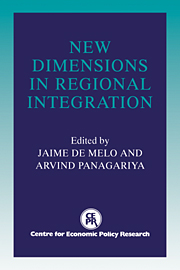Book contents
- Frontmatter
- Contents
- List of figures
- List of tables
- Preface
- Foreword
- Acknowledgements
- List of conference participants
- PART ONE SYSTEMIC ISSUES
- PART TWO COUNTRY ISSUES
- 6 The new regionalism: a country perspective
- Discussion
- 7 The European Community: a case of successful integration?
- Discussion
- 8 Regional integration in Sub-Saharan Africa: past experience and future prospects
- Discussion
- 9 Latin America's integration and the multilateral trading system
- Discussion
- 10 Regional integration in Eastern Europe: prospects for integration within the region and with the European Community
- Discussion
- 11 Regional trade arrangements in North America: CUSTA and NAFTA
- Discussion
- 12 Trading blocs and East Asia
- Discussion
- 13 Prospects for regional integration in the Middle East
- Discussion
- Round Table Discussion
- Index
10 - Regional integration in Eastern Europe: prospects for integration within the region and with the European Community
Published online by Cambridge University Press: 04 May 2010
- Frontmatter
- Contents
- List of figures
- List of tables
- Preface
- Foreword
- Acknowledgements
- List of conference participants
- PART ONE SYSTEMIC ISSUES
- PART TWO COUNTRY ISSUES
- 6 The new regionalism: a country perspective
- Discussion
- 7 The European Community: a case of successful integration?
- Discussion
- 8 Regional integration in Sub-Saharan Africa: past experience and future prospects
- Discussion
- 9 Latin America's integration and the multilateral trading system
- Discussion
- 10 Regional integration in Eastern Europe: prospects for integration within the region and with the European Community
- Discussion
- 11 Regional trade arrangements in North America: CUSTA and NAFTA
- Discussion
- 12 Trading blocs and East Asia
- Discussion
- 13 Prospects for regional integration in the Middle East
- Discussion
- Round Table Discussion
- Index
Summary
Introduction
In market economies, regional economic integration is achieved through the selective elimination of barriers against the movement of goods, services and factors of production among the integrating countries. Since private agents undertake the acts that are the subject of integration measures, the causes of integration are transparent and their economic consequences are subject to ready analysis and measurement. Among centrally planned economies (CPEs), such visible incentives to integration were irrelevant because foreign trade was a monopoly of the state, and the state's preferences toward trade with specific partners were implemented by means of administrative measures that were invisible to outsiders. This lack of transparency in the measures for integration among the members of the Council for Mutual Economic Assistance (CMEA) led to considerable confusion and controversy about sources, means and consequences of economic integration among these countries. Thus, now, as these countries face the task of reconsidering economic ties among themselves, and in the case of the former USSR within themselves, the question of which of these past flows of goods and resources ought to be retained and which should be eliminated, as well as the means of doing so, looms large on the agenda of the region's policymakers.
In this chapter, I examine the basis of CMEA integration and its effects on intra-regional trade in order to explain the legacy that it leaves for the region. Important aspects of this legacy include the volume and structure of past trade, as well as the economic benefits that it brought to the region.
- Type
- Chapter
- Information
- New Dimensions in Regional Integration , pp. 319 - 347Publisher: Cambridge University PressPrint publication year: 1993
- 5
- Cited by



